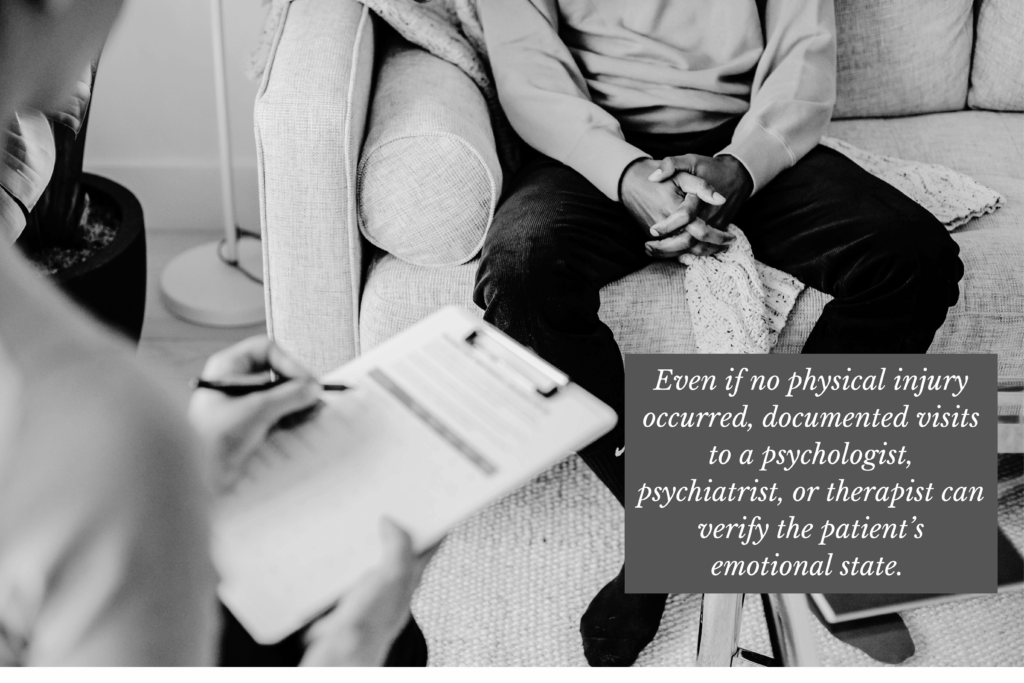Dealing with an accident can be very stressful, and that stress can linger for weeks, months, or even years after the incident. In severe cases, people even experience post-traumatic stress disorder (PTSD) which can affect day-to-day life.
Some accident victims try to ignore these impacts because they are difficult to prove, or too embarrassing to discuss. But it’s important to know that emotional trauma is real in the eyes of the law, and an experienced personal injury attorney can help ensure victims get the compensation they are owed.
Types of Emotional Trauma
Emotional trauma is a type of “non-economic damage.” This can include:
- Pain and Suffering – The physical pain caused by an injury and the emotional distress that comes with it.
- Emotional Distress – This involves the actual conditions of anxiety, depression, PTSD, and sleep disturbances.
- Loss of Enjoyment of Life – This includes the inability to participate in hobbies, sports, or everyday activities due to injuries. This can significantly impact a person’s happiness and well-being.
- Loss of Consortium – This is damage to a victim’s relationship with their spouse or family, affecting intimacy, companionship, and overall family dynamics.
- Disfigurement and Disability – Permanent scarring, amputations, or other visible injuries can affect a person’s self-esteem and social interactions, causing lasting emotional turmoil.
What Does Emotional Trauma Look Like?
Emotional trauma can manifest in different ways and sometimes it can appear weeks or months after an accident occurs. A psychologist or other doctor may diagnose the trauma sufferer with conditions like PTSD, generalized anxiety disorder, depression, panic disorder, or certain phobias. All of these disorders can be considered as bodily injury in New Mexico.
Signs that someone is suffering from emotional trauma after an accident include:
- Flashbacks or intrusive memories, in which the person relives the traumatic event
- Nightmares related to the accident
- Avoidance behaviors, such as refusing to drive or avoiding the location of the incident
- Heightened anxiety, irritability, or difficulty concentrating
- Increased heart rate or sweating when thinking about the accident
- Humiliation due to scarring or disfigurement
- Insomnia
- Alcohol or drug abuse that began after the accident
- Loss of enjoyment of life
- Increased anger
When a child is involved in an accident, emotional trauma may include some of the above, but also behaviors like:
- Crying when reminded of the event, such as when getting into a vehicle after a car accident
- Separation anxiety
- Fear of darkness
- Bed-wetting
- Misbehaving
- Changes in social behaviors, such as not wanting to play with other children
- Poor grades
It can be helpful to document any changes in behavior or feelings after an accident, or to see a therapist early on. This is important, not only for treating the problem, but also for documenting how the accident has impacted personal life and activities.
Making the Decision to Sue for Emotional Distress
It’s easiest to move forward with suing for emotional distress when there is a physical injury, because it is simpler to prove that physical injuries cause pain and trauma. However, people can also suffer from emotional distress if no physical injury is present. While it can be more difficult to sue in these cases, there are laws allowing for compensation when no physical injury occurs.
The “impact rule” does not allow for recovery for emotional distress unless the plaintiff proves actual physical contact of some kind occurred. This impact rule is meant to prevent fraudulent claims by providing an objective proof of reasonable fear. However, in cases of negligence, the “zone of danger” rule allows for recovery when a person is placed in immediate risk of physical harm by a defendant’s negligence–and that risk causes fear and distress. There are also some claims in which witnessing accidents involving family members allows for recovery, such as Negligent Infliction of Emotional Distress (NIED).
Regardless of physical injury or other economic damage, someone that has been in an accident can–and should–sue for emotional distress caused by the event, as long as they are experiencing any of the symptoms of emotional trauma.
The decision to make a claim is personal, but the compensation can help make up for loss of productivity or help to pay for treatments leading to a healthier and happier life after the accident.
Making the decision to go forward with filing an emotional trauma claim in New Mexico can be daunting, but a good lawyer can put everything in perspective and help you understand what kind of damages you are entitled to. The emotional trauma claim may be a part of a broader personal injury claim, encompassing lost wages, medical bills, and emotional trauma, or any combination of these.
Proving Emotional Trauma for a Claim in New Mexico

When filing a claim for emotional trauma in New Mexico, a lawyer will offer advice on gathering as much evidence as possible to help prove they are suffering. This might include:
Medical records. If the claimant did suffer a physical injury which led to emotional damage, they can use hospital bills and doctor visits proving the severity of the injury.
Therapy visits. Even if no physical injury occurred, documented visits to a psychologist, psychiatrist, or therapist can verify the patient’s emotional state. A therapist may also provide testimony to the patient’s condition.
Testimonies from family, friends, or co-workers. Anyone close to the victim who has witnessed the negative emotional changes can attest to the impact of the accident.
Personal testimonies from the injured person. Pain journals, videos, and pictures taken over time can be helpful in showing the impact of emotional trauma.
How is Compensation Determined for Non-Economic Damages in New Mexico?
Typically, if the claimant is found to have emotional trauma, non-economic damages are calculated by either the multiplier method or per diem method.
Multiplier Method – A method for determining the compensation of non-economic damages, where the claimant’s economic damages, like medical bills and wages, are added up and multiplied by a factor between 1.5 and 5. This factor is determined by the severity of injury, proof of pain and suffering, the degree of fault of the other person, and whether recovery from injury is possible. The worse the impact is, the higher the factor is, which leads to increased compensation.
Per Diem Method – In this method, the claimant is compensated for non-economic damages based on a daily amount that is multiplied by the number of days they have suffered or are expected to suffer. The daily amount is often the amount of their lost wages per day.
Finding the Right Lawyer Goes a Long Way in an Emotional Trauma Claim
Insurance companies and lawyers for the at-fault person will always try to pay out the smallest amount of compensation possible. Many people will have a difficult time proving emotional damage, especially when they are already under a lot of stress. This is where a good lawyer can make a big difference.
If you’re experiencing emotional trauma after an accident, it’s crucial to find a lawyer with a lot of experience in personal injury and emotional trauma claims in New Mexico, like those at Kane Personal Injury. We’re dedicated to getting our clients the settlements they deserve. Schedule a free, no-obligation consultation today to find out more about your options.
